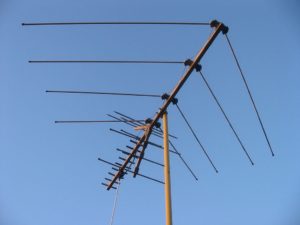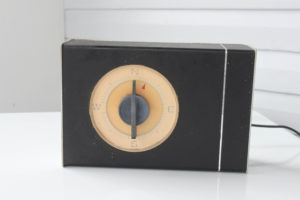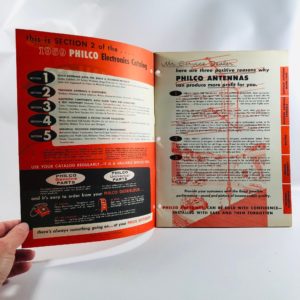
One of the most familiar suburban sights used to be television antennae on the rooftops. You saw so many of them that they became invisible. In the town where I grew up, we had TV stations from 30 to 60 miles away that we watched. Two (later three, when a UHF station went on line in 1968) were north of us, about twenty degrees apart. The other three were in Tulsa, about 150 degrees to the left.
That meant our antenna had to be turned to get the best pictures. Those rooftop antennas were quite directional. They needed to be pointed directly at the transmission tower to get an optimal signal.
Channel seven in Pittsburg, Kansas, and channel twelve in Joplin, Missouri were close enough aligned that splitting the difference between them gave an acceptably sharp picture.
But if we wanted to watch Red Skelton, Ed Sullivan, or any other CBS offerings, we had to tune in channel six from Tulsa. That meant the antenna needed to be rotated.
My normally acute memory escapes me when I try to remember what dad did before we purchased a rotor. I know he did SOMETHING, because we watched the Tulsa stations frequently. Perhaps we just lived with snowy pictures. We had a black-and-white TV at the time, and the bicolor medium was much more forgiving of weak signals than its color counterpart.
But I do remember dad getting that rotor. It was immediately after purchasing our first color TV.

The problem with color TV and a misaligned antenna wasn’t the snow. It’s amazing how poor a picture we were willing to accept back then, in this day of 48″ plasma hi-def’s. No, the problem was that the color ITSELF would come and go with a less-than-optimal signal. And having the picture go from b&w to color and back in the course of a few seconds was simply too much to bear.
So, my thrifty father saw fit to invest a few bucks into having an installer come out and put a rotor on our antenna. It was powered by a controller with the Tulsa, Pittsburg, and Joplin alignments preset. You just turned a pointer to the desired location, and the rotor would obey with a “cachunk . . . cachunk” repeated until the light that marked the antenna’s actual direction would meet the pointer’s location. Presto! KVOO in perfect glory!
Rotors worked well for a while. Then, the quality of the rotor determining how long it would take, it would begin freezing up along its path of rotation. You could frequently get past the bad points by backing it up a bit and trying again. But eventually, it would freeze solid. Then, you had a perfect picture from somewhere (if you were lucky) and poor pictures from everywhere else.
Now, you were sunk. You weren’t about to go back to b&w, and you also weren’t going to tolerate color that came and went. So you had to spring for a new unit.
When the above scenario took place later at our home outside Pea Ridge, Arkansas, dad refused to give in. Our antenna pole went down alongside the house, so it was possible to rotate it manually. However, the antenna’s guy wires didn’t allow a full 360 degree turn. So we were still stuck watching Fort Smith’s channel five. But channel five showed all three networks in those days in an arrangement that seems strange today. Its audience decided through letters and phone calls what shows should be shown when. So one station showed shows from the Big Three, frequently switching from CBS top ABC to NBC during the course of a single evening!

But I missed the familiar faces for channel seven’s newscasts. I grew up listening to Vic Cox giving sports reports about the Oklahoma Sooners as well as Kansas and Kansas State. KFSM was OBSESSED with one team, the Razorbacks of Arkansas. And there was NO other team worth reporting on, in their opinion (and that of its audience, myself excepted).
So, I kept turning that antenna hard against those guys until one of them finally snapped off! FINALLY, I was able to get that blasted antenna pointed towards Pittsburg again. Vic Cox’s bald head was a welcome sight, and so was news about OTHER college teams.
Of course, that weakened antenna probably fell over soon after we moved away from that place.
Recently, I installed a small amplified multi-directional antenna in my attic which enables me to watch our local networks in hi-def, something that Dish Network unfortunately does not yet offer in my area. As I tuned into my local station and was now able to see every blade of grass on Augusta National’s fairways, I reflected on how I had ditched my antenna circa 1984, and had returned to it twenty-three years later.
However, I’m stopping short of installing a rotor.